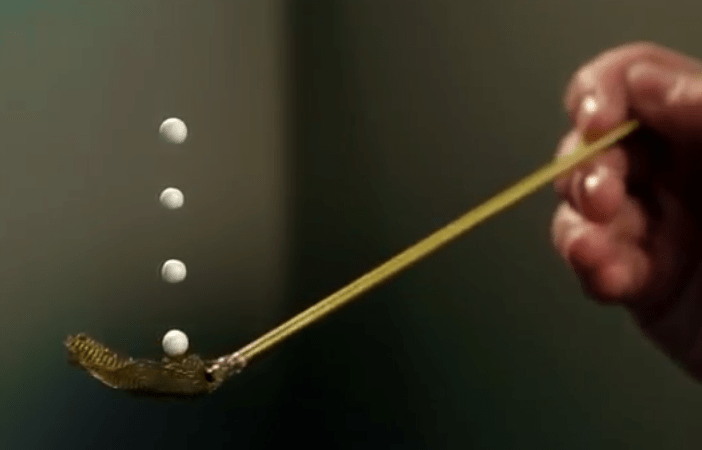It’s not special effects: researchers at the U.S. Department of Energy’s Argonne National Laboratory in Illinois have developed a way to cancel out the effects of gravity, allowing liquids to be held without containers. The effect is created using sound waves emitted by an acoustic levitator — an instrument designed by NASA for simulating microgravity.
Watch the video. It’s the coolest thing you’ll see all week.
This accomplishes more than just a neat effect; by keeping liquids in place without the need for a physical container, pharmaceutical research can be performed while the drugs are still in their purest, “amorphous” state.
“Most drugs on the market are crystalline – they don’t get fully absorbed by the body and thus we aren’t getting the most efficient use out of them,” said Yash Vaishnav, Argonne Senior Manager for Intellectual Property Development and Commercialization.
When solutions come in contact with the interior surfaces of their containers, evaporation takes place, which can lead to crystallization. In order to find a way to hold liquids without anything coming in contact with them (a tricky task while under the effect of Earth’s pesky gravity) ANL X-ray physicist Chris Benmore looked to NASA’s acoustic levitator.
Using two sets of sound waves emitted at 22khz and precisely aimed at each other, a “standing wave” is established at their center. The resulting acoustic force is strong enough to counter the downward tug of gravity at certain points (at least as far as droplets of liquid are concerned.)
The liquid drugs can then be studied without the problem of crystallization, making this technological parlor trick a powerful analytical tool for pharmaceutical researchers. The ultimate goal is to learn how to reduce the amount of a particular drug but still retain the desired effects — with less of the undesired ones.
Read more here on the Argonne National Lab site.
The nation’s first national laboratory, Argonne conducts leading-edge basic and applied scientific research in virtually every scientific discipline. With employees from more than 60 nations, Argonne is managed by UChicago Argonne, LLC for the U.S. Department of Energy’sOffice of Science.


Absolutely amazing! I would imagine this has some applications in fusion research. Considering the need to contain the target of fusible material in a way that would not make any physical contact, this seems like an ideal application. Very cool technology!
Except fusion typically also requires vacuum…
nothing new, i saw this in X-MEN latest, the guy that was flying using his powerful sonic waves reverbs :))
So many possibilities.
I am totally seeing Zero Gee or Low Gee applications in this! Foamed metal fabrication on the moon anyone? Here, let me levitate and mix those molten metals and gas for yah?
I don’t see how you could get a sonic wave in a vacuum. Maybe in a Lunar habitat?
Or molten metal and glass – see-through nuclear submarines!
I agree – some great potential here. A new anti-grav lev method of transportation?
I guess I’m not understanding something. This effect seems to be levitation but not zero G. Liquids without containers – great. But the drop is still in a one G field. Yes?
Yeah, the device has got nothing to do with zero G but everything to do with evaporating a liquid without holding it in a container.
Yes it’s not “removing” gravity obviously, but rather canceling its effect with acoustic forces, creating a microgravity-like environment in a lab on Earth. Handy.
Ohh kay. But it is not really a ‘microgravity-like environment’, is it? If you have particles in the drop of liquid that are heavier than the liquid they are in they are still going to settle to the bottom of the drop – yes?
I guess I’m picking nits. I’ll stop now.
I don’t know… the particles could get vibrated by the acoustic waves to float around within the droplet… no?
I thought about that, too. May be. Still not microgravity but maybe microgravity-like. Yes.
I’m not sure I understand. So sonic levitation is used to prevent the evaporative crystallisation in liquids that is normally caused at the point where the liquid touches a container. But with no container and more surface area exposed to air, doesn’t that mean more evaporation is likely?
Oh, wait. I’ve read the Argonne version and evaporation is exactly what they want in the liquid, to reduce it down to an amorphous (rather than crystalline) solid. I had assumed that crystallisation always occurs with evaporation, container or not.
transfer of power I see as the future. We us so much fuel to just heat water to make steam to turn into electric power. To much cave man waste to move things.
Awesome way to store some anti-matter!